
The idea of the Lines of Torres Vedras is generally thought to have been developed by Lord Wellington in late 1809, with the design carried out by British Royal Engineers officers Richard Fletcher and John Jones. The achievements of these men in the construction of these works are undeniable; their work was tireless and carried out with great talent. In their reports, the British officers understandably emphasised their own role in the general supervision of the construction of the lines. This was natural given the command structure as Fletcher and Jones had the overall responsibility for the supervision of the construction of the lines and reported to Wellington. The reports and the memoirs of these and other officers were eventually published in Britain after the Peninsular War. As a result, the English-speaking public were led to believe that, apart from the thousands of Portuguese peasants who provided the manual labour to build the various works and a few Portuguese military engineers, the entire system had been conceived and the construction directed by British military engineers.

A peasant of Torres Vedras, c. 1810. Thousands of such men were drafted to build the works forming the lines. Print after Bradford. (Pedro de Brito Collection, Porto)
In fact, the idea of building a line of defence between the Atlantic Ocean and the Tagus River had been considered by Portuguese military planners since the latter part of the 18th century. However, at the time there was no threat to Lisbon and such schemes remained entirely theoretical. The British took a similar approach and their first plan was conceived in 1799 by General Sir Charles Stuart, who commanded the British and Émigré troops posted in Portugal. In 1802, the Portuguese government resolved that a topographical map of the country should be made and Lieutenant-Colonel Carlos Frederico Bernardo de Caula was put in charge of the work. He was helped by Captain José Maria das Neves Costa. These engineer officers naturally saw the possibilities for a line of defence north of Lisbon. As a result the initial plans for such fortifications were drawn up by Captain Neves Costa in 1806 and 1807. Indeed, it was Colonel Charles Vincent of the French Imperial Corps of Engineers who next saw the possibilities. He was with General Junot’s army that invaded and occupied Portugal in November and December 1807, learned of Caula’s and Neves Costa’s work and submitted a proposal to Junot in early 1808 for building fortifications north of Lisbon. Nothing was done, although Napoleon later felt that Junot and his army would have been saved by such works. From October 1808, after the French had been compelled to evacuate Portugal, Neves Costa was appointed to draw up a detailed plan. It was a huge project. Neves Costa finished the plans on 4 March 1809 and the accompanying memorandum on 6 June. They were then presented to Wellington for consideration. From that point the plan became a British responsibility.
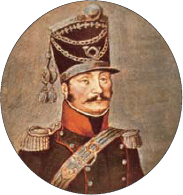
Colonel Shée of the 13th Chasseurs à cheval, c.1812. There were 20 officers and 250 troopers of the 13th engaged at Fuentes de Oñoro.

The Lines of Torres Vedras and the fortifications near Lisbon, 1810–11. The 3rd and 2nd lines had mostly British troops and are shown in red whereas the 1st line had mixed Portuguese (yellow) and British (red) garrisons. The French are shown in green. The positions towards the top of the map are those during the French retreat in the spring of 1811. (Luz Soriano, III)
Wellington had his own engineers with his British army in Portugal, and he called on them to evaluate Neves Costa’s plan. The idea of a defence line north of Lisbon had interested him when in Portugal in August and September 1808. He had then seen the late General Stuart’s plan made nine years before, as well as Colonel Vincent’s proposal. Now, with Neves Costa’s detailed work, the notion could be put to the test. In October 1809, Wellington took the time to survey the area for himself guided by Neves Costa’s maps and accompanied by his senior engineer, Lieutenant-Colonel Richard Fletcher and the quartermaster-generals of the British and Portuguese armies. The reconnaissance was thorough and when it was over, Wellington had seen just about every hill, valley, river and road between the Atlantic and the Tagus north of Lisbon.
To his everlasting credit, Wellington made the decision to go ahead and build the proposed defences. On 20 October 1809, Wellington sent Lieutenant-Colonel Fletcher a long and detailed instruction regarding the works to be prepared. There would be two lines of redoubts and trenches on two ranges of hills. The first and most northerly, running from the estuary of the Zizandre River on the Atlantic through Torres Vedras to Alhandra on the west bank of the Tagus, would have four large redoubts capable of holding several thousand men each at the towns of Torres Vedras, Sobral, Arruda and Alhandra. A second line would be built between Carvoeira and Alverca should the French break through the first line. Naturally, there were changes made by Wellington’s British engineers, in particular that a large defensive position be built at the entrance of the Tagus River. This was the last line of defence in case the lines could not be held and the army should have to be evacuated by sea. Neves Costa’s plan had called instead for an all-out defence of Lisbon. There were various other adjustments, but on the whole Neves Costa’s plan of a line of fortified positions remained the basis of the defences.7
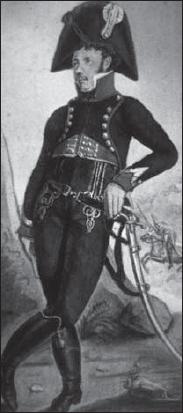
Maréchal-des-logis (Sergeant) Le Saché, 22nd Chasseurs à cheval, 1810. Apart from wearing a shako instead of a bicorn, the dress shown was much the same during the campaign. The 22nd was part of Reynier’s 2nd Corps.
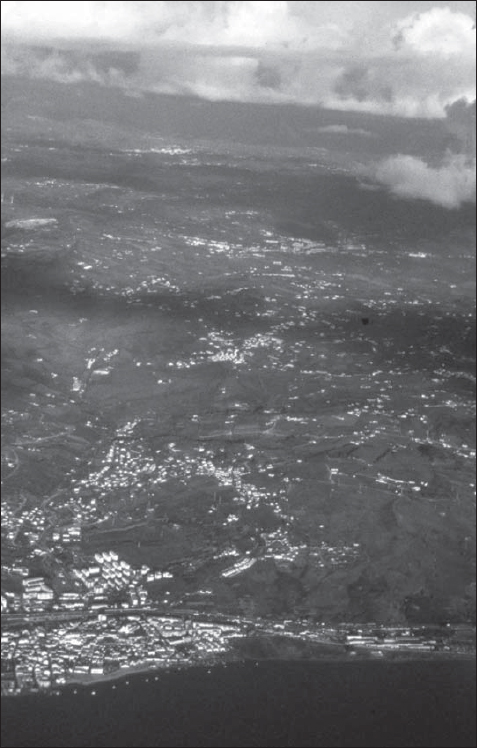
Aerial view of the peninsula north of Lisbon between the Tagus River (bottom) and the Atlantic in the distance. Now considerably built up with housing, this was the general area of the Torres Vedras lines. (Photo: RC)
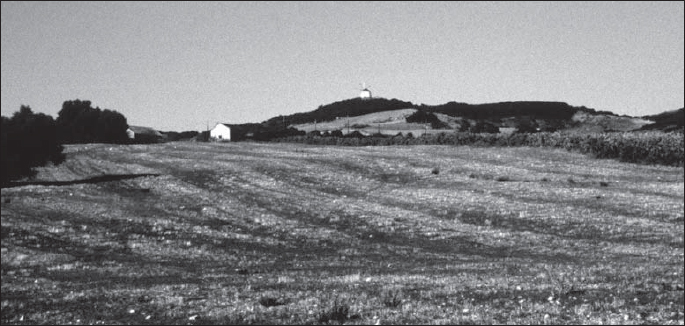
The scenery in the area of the Lines of Torres Vedras between Cadafaes and Arruda that largely escaped development. Then as now, small windmills were a common sight on the hills. (Photo: RC)
Captain Jones, who later became the British ‘historian of the Lines’, attributed the supervision of the construction to Lieutenant-Colonel Fletcher and himself along with three Royal Engineers captains, eight lieutenants, a captain and a lieutenant of the King’s German Legion engineers and, lastly, to three lieutenants of the Portuguese engineers. Besides these officers named by Jones, at least six more British engineer officers worked on the lines. Some 20 British engineer officers thus worked at erecting 154 fortified works, some of them quite extensive, which made up the lines as well as repairing existing forts and building other works on the coast.8
As the Portuguese Royal Corps of Engineers had over 90 officers in the country, one might wonder as to why so few Portuguese engineers worked on the lines. The answer, as furnished by the service records of Portuguese engineer officers, is that at least 39 of them did in fact work on the construction of the lines and other related fortifications in the Lisbon area. This makes much more sense and explains where many of the Portuguese officers were and what they were doing.9
The three Portuguese engineers mentioned by Captain Jones worked under the direct supervision of the British Royal Engineers. At first glance, this could be the reason why only they were given credit for the work. Jones would naturally report on the work of his own British Royal Engineers. But again the service records indicate that there were nine rather than three officers of the Portuguese Royal Corps of Engineers who were detached serving ‘under the orders of Lt. Col. Fletcher’. Another two were reported under Captain ‘Squier’ (Squire) of the British Royal Engineers in January 1811. All this data indicates that the numbers of British, and especially of Portuguese, engineers working on the fortifications were substantially higher. There were therefore some 20 British and nine Portuguese engineers working under Fletcher’s direct orders and about 30 other Portuguese engineers working elsewhere on the line or in related works being erected in 1809–10.10
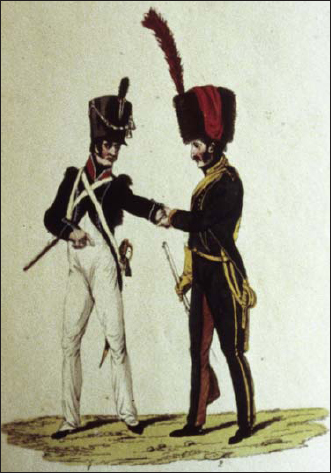
French 27th Light Infantry and 5th Chasseurs à cheval, c.1811–12. The 27th is shown with white waistcoat and trousers, more suitable in the Peninsula’s heat than the regulation blue. The Chasseur à cheval wears the fur busby indicating he is an elite trooper. (Print after Goddard and Booth)
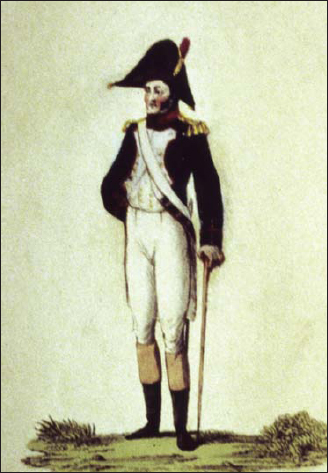
Grenadier officer of the French 94th Line Infantry, c.1811–12. A battalion of this regiment was in the 9th Corps at Fuentes de Oñoro. (Print after Goddard and Booth)
What all these engineers were asked to build was a most innovative work. The ‘lines’ were not a continuous wall such as Hadrian’s Wall or the Wall of China. The works that had been conceived by the Allied engineers and reviewed by Wellington, were a complex and numerous set of redoubts, forts and trenches, the first example in modern history of defences in depth on such a vast scale. Great numbers of fortifications would be built on top of hills strung out in the two lines. The fields of fire of these forts would be largely overlapping so that an attack on any fort would always be caught in the crossfire from those on either side. In addition, innumerable trenches and other obstacles further linked and strengthened the system.
The heights of Almada overlooked the River Tagus and the city of Lisbon from the south. It was possible that a strong French force could outflank the lines by marching down on the east bank of the Tagus and occupy the heights. Should this occur, the French would then be able to block the Tagus and bombard Lisbon. The older forts at Almada were therefore refurbished and 17 new redoubts spread over 7 km built inland. These works were equipped with 86 guns and could accommodate up to 7,500 men. A telegraph station was installed to communicate with the lines. Detachments of militia and the Lisbon Royal Commerce Volunteers manned these works.
The final work built east of Lisbon was a semi-circular line of defences at Sao Juliao (or St. Julian). It was called the 3rd Line. Should the lines above Lisbon collapse under the French army’s attacks, the British and Portuguese troops that could, were to fall back to this point to embark on vessels that would evacuate the army. A strong fort was built outside this fortified enclosure and within it were redoubts and four large jetties to embark the troops. Wellington may not have believed he would ever have to evacuate the Allied army, but it was a safe measure to take which also reassured the politicians.
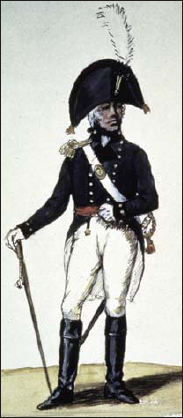
Officer of the Royal Engineers, c.1802. Until 1813, the engineers had a blue uniform faced with black velvet and gold buttons. C.C.P. Lawson after Loftie. (Anne S.K. Brown Military Collection, Brown University, Providence, USA)
On 6 October Wellington divided the two lines above Lisbon into six districts and assigned garrisons for their forts. Almada and Sao Juliao were not included in this system as they constituted a last redoubt. Neither was the flotilla on the Tagus nor the troops detached east of the Tagus who were mostly watching for French movements in the general area of Santarem. Finally, there was the fortress of Peniche at the end of a narrow peninsula on the Atlantic situated north of Masséna’s army. Peniche was the general training centre for the Portuguese infantry, and it was unlikely that Masséna would commit a substantial part of his army to take it, as this would further weaken his force at the Lines of Torres Vedras. He did not attempt to take Peniche but remained worried that the British might use it to land troops and attack his rear. A cordon of French troops stood guard outside the Peniche peninsula to warn Masséna of any such movement.
District No. 1. From Torres Vedras to the sea.
HQ Torres Vedras.
2,470 militia infantry, 250 Ordenanza artillery, 140 regular Portuguese artillery, 70 British artillery.
District No. 2. From Sobral de Monte Agraço to the valley of Calhandriz.
HQ Sobral de Monte Agraço.
1,300 militia infantry, 300 Ordenanza artillery, 140 regular Portuguese artillery, 40 British artillery.
District No. 3. From Alhandra to the valley of Calhandriz.
HQ Alhandra.
400 militia infantry, 60 Ordenanza artillery, 60 British artillery.
District No. 4. From the banks of the Tagus to the valley of Calhandriz.
HQ Bucellas.
1,100 militia infantry, 500 Ordenanza artillery, 80 regular Portuguese artillery.
District No. 5. From the pass of Freixal to the right of the pass of Mafra.
HQ Montachique.
2,400 militia infantry, 480 Ordenanza artillery, 120 regular Portuguese artillery, 50 British artillery.
District No. 6. From the pass of Mafra to the sea.
HQ Mafra.
700 militia infantry, 350 Ordenanza artillery, 230 regular Portuguese artillery, 40 British artillery.
The forbearance of the Portuguese people through this most tragic period in their country’s history was extraordinary and admirable. When the French invaders crossed into Portugal hundreds of thousands of civilians fled before them and found refuge behind the Lines of Torres Vedras; their last hope. Sir John Colborne of the 52nd Light Infantry wrote to his sister of the distress he witnessed in the town of Alhandra, where the ‘unfortunate inhabitants’ had ‘all left their houses, and their furniture, poor people, is converted into barriers, &c. How should you like to see your piano, your writing tables, chairs and trunks heaped together at the south end of Sloane street to impede the enemy’s march?’ he painfully asked. But the tragedy was, in fact, striking a large part of the population and Colborne, no doubt like all who witnessed it, was profoundly affected. He confided that he had ‘never seen so much distress and misery experienced by the mass of the people as in the late flight of the inhabitants towards the capital. Not a person remained in his home, whole towns and villages decamped, taking with them only what a cart could convey, and leaving the rest of their property to be pillaged by the armies of friends and enemies.’11
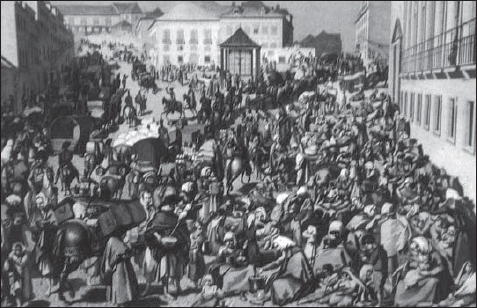
Tens of thousands of refugees who abandoned their homes as the French army approached found safety behind the Lines of Torres Vedras in the autumn of 1810. Most were ruined by the invasion, their livelihood and homes destroyed and their hardships such that many once prosperous families were reduced to begging for food. This contemporary print shows a great crowd of refugees at a food distribution point at the convent of Arroios in Lisbon. (Museu Militar do Bussaco)
Captain John Jones of the Royal Engineers saw the ‘immense crowds of fugitive Portuguese – men, women and children’ come into the Lines of Torres Vedras, blocking every road. As if the sorrow of their flight from the French was not enough, the ‘autumnal rains set in at this very moment, pouring down in torrents, accompanied by severe thunder and lightning, filling the streams and watercourses, and rendering the roads deep and heavy’. Such conditions added to the utter misery of a desperate situation that countless innocents had been plunged into.
7 Wellington never actually saw Neves Costa but nevertheless in 1812 criticised his work as being inaccurate and needing to be redone. However, the lines as built largely followed Neves Costa’s suggestions. The background on the various plans of the lines and on the work of Neves Costa is given in Maghaleas Sepulveda, Historia Organica …, XIII.
8 The British officers mentioned by Jones were Captains William C. Holloway, J. Williams, S. Dickinson and Wedekind (KGL), Lieutenants F. Stanway, A. Thomson, W. Forster, S. Trench, R.S. Piper, H.A. Tapp, William Reid, J.L. Hulme and Meinecke (KGL). The three Portuguese officers are named as Lieutenants Lourenzo Homem, Souza and Britto. They were actually Majors Lourenço Homem da Cunha de Eça, Manuel Joaquim Brandao de Sousa and Captain Joaquim Norberto Xavier de Brito. The other British officers were Captains George Ross, S.R. Chapman, J. Squire and Henry Goldfinch, E. Mulcaster, P. Wright and Rice-Jones. Captain John Burgoyne and Lieutenant Stanway were also at the lines, along with the engineers with Wellington’s Allied army, which retired behind the line in early October 1810. These did not participate in the building but were used to supervise upkeep. From 6 October, engineers were assigned to each district as follows: No. 1: Captain Mulcaster and Lieutenant Thompson, No. 2: Captain Goldfinch and Lieutenant Forster, No. 3: Captain Squire and Lieutenant Piper, No. 4: Captain Burgoyne and Lieutenant Stanway, No. 5: Captain Dickenson and Lieutenant Trench, No. 6: Captain Ross and Lieutenant Hulme. W. Porter, History of the Corps of Royal Engineers (London, 1889), Vol. 1, has 20 Royal Engineer officers working on the lines. There were also 18 Royal Sappers and Miners supervising labourers.
9 In 1812, Halliday reported that the Portuguese Royal Corps of Engineers consisted of eight colonels, 13 lieutenant-colonels, 27 majors, 22 captains, 11 first lieutenants and 11 second lieutenants for a total of 92 officers. This is confirmed in Maghaleas Sepulveda, Historia Organica …, V, which is a detailed history of the Portuguese engineers to 1816. The service records of Portuguese officers are on pp. 308–320 of which 39 are reported as having worked on the lines. The services of 36 others show them on every front, many serving with the Allied army until 1814.
10 The six other Portuguese officers were: Francisco Antonio Raposo, Bernardo José Pereira dos Santos Franco, Francisco Villela Barboza, Luis Maximo Jorge de Bellegarde, Joao Antonio d’Almeida Cibrao and Henrique Luiz Aschoff. Joaquim Pedro Pinto de Sousa and Jacvinto Joaquim Torcato Xavier were under Squire in January 1811. See Maghaleas Sepulveda, Historia Organica..., V for details. This somewhat contradicts most British accounts and histories published since the 19th century but Portuguese sources have, unfortunately, usually been ignored in most English-language publications. Sir Charles Oman did use them, notably Luz Soriano’s Historia da Guerra Civil, but his volumes appeared before Maghaleas Sepulveda’s detailed studies in the 1910s and 20s. Prof. David Horward has also made extensive use of Portuguese sources.
11 Sir John Colborne to his sister Alethea, Alhandra, 9 November 1810, in Moore Smith, The Life of John Colborne, p.146.